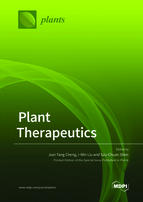Plant Therapeutics
A special issue of Plants (ISSN 2223-7747). This special issue belongs to the section "Phytochemistry".
Deadline for manuscript submissions: closed (25 July 2022) | Viewed by 46958
Special Issue Editors
Interests: natural products; pharmacology; diabetes; therapeutics; herbs; bioactivities
Special Issues, Collections and Topics in MDPI journals
Interests: natural compounds; medicinal plants; polyphenols; plant extracts; phytotherapy; pharmacology; toxicology; antioxidant activity; anti-inflammatory activity; cytoprotective activity
Special Issues, Collections and Topics in MDPI journals
Interests: natural products; herbs; bioactivities; therapeutics; health food; diabetes; non-alcoholic fatty liver disease
Special Issues, Collections and Topics in MDPI journals
Special Issue Information
Dear Colleagues,
Plants contain many principles and some of those principles are beneficial for human health. However, many unclear points remain despite the best efforts of many researchers. Particularly, ethano-herbs and/or classical plants are widely used around the world. Therefore, this Special Issue will focus on these points. Additionally, combinations of plants and/or plant combined modern medicine are also popularly used in therapeutics. It is important to assess the renowned historical significance of products contained in plants. Be free to share useful plants that are applied in your local market, using a reliable model of disorders to indicate the effectiveness in therapeutics. Moreover, considering the high interest in plant-derived effectiveness in health as an emerging challenge for modern therapies, this Special Issue will cover a wide variety of areas, aiming to contribute to the overall knowledge of medicinal plants from several perspectives. Scientific papers, including review, mini-review, commentary, original research, and others, are all welcome from everywhere around the world.
Prof. Dr. Juei-Tang Cheng
Prof. Dr. I-Min Liu
Prof. Dr. Szu-Chuan Shen
Guest Editors
Manuscript Submission Information
Manuscripts should be submitted online at www.mdpi.com by registering and logging in to this website. Once you are registered, click here to go to the submission form. Manuscripts can be submitted until the deadline. All submissions that pass pre-check are peer-reviewed. Accepted papers will be published continuously in the journal (as soon as accepted) and will be listed together on the special issue website. Research articles, review articles as well as short communications are invited. For planned papers, a title and short abstract (about 100 words) can be sent to the Editorial Office for announcement on this website.
Submitted manuscripts should not have been published previously, nor be under consideration for publication elsewhere (except conference proceedings papers). All manuscripts are thoroughly refereed through a single-blind peer-review process. A guide for authors and other relevant information for submission of manuscripts is available on the Instructions for Authors page. Plants is an international peer-reviewed open access semimonthly journal published by MDPI.
Please visit the Instructions for Authors page before submitting a manuscript. The Article Processing Charge (APC) for publication in this open access journal is 2700 CHF (Swiss Francs). Submitted papers should be well formatted and use good English. Authors may use MDPI's English editing service prior to publication or during author revisions.
Keywords
- Functional product
- Plant combination
- Effectiveness in therapeutics
- Animal model
- Human health
Related Special Issue
- Plant Therapeutics 2.0 in Plants (7 articles)







